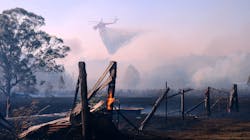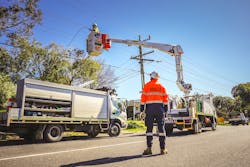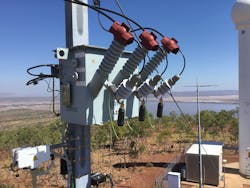Unfortunately, much of the devastation is a direct result of human activity — including sparks originating from assets that make up our electrical grid. According to a government investigation into the Ash Wednesday wildfires in 1983, 29 of the 190 fires were started by malfunctioning assets on the electricity grid — or roughly 15 percent. I remember sitting on my mother’s front porch in 1983, watching embers fly over our property from flames more than 50 kilometers away. An investigation after the Black Saturday wildfire in 2009 found that five out of the 11 major fires were sparked by power lines.
Considering the destructive nature of wildfires in the region and the potential for a loss of life, the electric utilities here in Victoria and other fire-prone regions around the world have an obligation to our community, our environment and our shareholders to make our grid as resilient as possible. The benefits of a resilient network go well beyond preventing fires. Access to electricity helps provide the lifeline that communities need to stay informed and connected with family, friends and neighbors, which is particularly important during wildfire season. Similarly, an uninterrupted electricity supply can be invaluable for maintaining pumps and other essential home systems in case of emergency, especially in remote areas.
It is going to require a commitment from the industry, customers and governments to purchase, deploy and maintain new fire prevention technology to prevent fires from breaking out before they start. A collaborative effort is required to mitigate the growing danger of more frequent wildfires from climate change.
And, Of Course, It’s Getting Worse
As temperatures continue to climb and extreme weather increases the frequency and magnitude of droughts and dry conditions, the devastation wrought by catastrophic wildfires are the number one risk to the industry. According to the National Council for Fire and Emergency Services, the Australian wildfire season has increased an entire week per year over the past decade. That means that there are an additional 70 days per year of extreme wildfire risk today than in 2011. That’s 70 more days of heightened vigilance for our networks and the community.
United Energy, the third largest utility in the state (and my employer), has 10 percent of our total assets in areas determined to be at a high risk of wildfires. This includes cabinets, transformers and overhead wires that traverse forest grass and leaf litter. A simple spark is all that is needed to ignite the dry vegetation and start a fire.
Three Strategies for Reducing Wildfire Risk
The industry needs to develop fire reduction strategies that prevent fires from starting in the first place. This includes improving design standards for existing equipment, developing new technology solely dedicated to spark prevention and leveraging better asset management strategies that prevent overvoltages from occurring in the first place.
Improve Design Standards
Most legacy equipment on the grid is rated for 35 degrees Celsius (95º F)—an understandable cap from a time when temperatures rarely exceeded that limit. But the world is a hotter place than it was 50 years ago when these assets were first manufactured and deployed in the field. It now regularly gets over 40 degrees Celsius (105º F) throughout the summer months in Victoria, and it’s not uncommon for it to top 45 degrees Celsius (113º F). Other fire-prone areas in the American West (including California and Colorado) and Spain are experiencing rising temperatures as well.
While many equipment manufacturers already stress test their products to perform under today’s extreme weather conditions, regulations that force all equipment manufacturers to meet higher temperature standards (such as 50º C) would go a long way toward reducing asset malfunctions that result in sparking. This would improve safety features across the board and greatly reduce wildfire frequency.
Develop Spark Prevention Technology
A potential area of risk that is being addressed, in cooperation with suppliers like Hitachi Energy, is surge arresters installed on overhead distribution wires, which can be a source of sparks that potentially leads to wildfires. They work by protecting critical assets from overvoltages due to lightning, overheating or even routine switching events. If the overvoltage is particularly severe in terms of size or duration, the surge arrester is designed to sacrifice itself to protect downstream electrical equipment. Depending on the voltage surge, these events can be quite dramatic, releasing hot gasses that spontaneously spark.
Utilities now have the option to deploy spark prevention units (SPUs) to reduce wildfire risk caused by thermally overloaded surge arresters. Installed directly on surge arresters in areas at high risk of wildfires, SPUs monitor the current and thermal load of the surge arrester and automatically disconnect it from the network in the event of thermal overload. This prevents any arcing, sparking or ejection of hot particles that may ignite nearby vegetation.
Developed specifically to reduce the risk of fire in Australia and California, tens of thousands of SPUs are now deployed in high-risk areas around the world. The SPU can be deployed on networks in every kind of terrain, regardless of location, and it’s been a great way to eliminate one potential fire hazard and deliver out-of-sight, around-the-clock protection without the need for boots on the ground.
Commitment to Better Asset Management
A very large portion of our network (around 80 percent) is strung overhead and is exposed to a wide variety of potential sources of damage that can be highly unpredictable. Unfortunately, animals such as birds, bats and possums get caught in our overhead lines and, on occasion, can present a fire hazard. Using digital monitoring systems, however, we can detect and receive alerts about irregularities on the network caused by such incidents. Asset management strategies can provide new insights into grid health and behavior through real-time awareness in the control room.
Operators can use remote monitoring solutions to gain near real-time control and analysis of grid production and health as well as a range of insights used for predictive optimization and planning. Manufacturers such as Hitachi Energy are proposing digital solutions to monitor the state of surge arresters anywhere on the grid to increase reliability and safety. The wireless monitor for surge arrester, for instance, records surge events as well as leakage current, environmental conditions such as ambient temperature and humidity and transmits this information via long range-low power network communication. Powered by batteries, this kind of monitor can be placed anywhere on the electrical grid and transmit information on a regular basis, contributing to the increased resilience of the grid.
Powered by artificial intelligence (AI) and machine learning (ML), there’s a whole range of digital solutions that allows operators to watch energy flow, turn generating sources on and off, monitor energy quality, warn technicians about live wires and conduct other actions remotely and automatically. Imagine being warned of an impending overvoltage event and being able to simply turn off that asset and redirect load over other infrastructure without disrupting supply. Or, better yet, automate those predictive and proactive actions without needing human interaction.
The Time to Act is Now
Climate change is a problem that’s not going away. Rising temperatures and more devastating events are going to continue to threaten the electrical grid and potentially cause more wildfires. With lives, property and wildlife being put at great risk, it is essential that the industry take the necessary steps to commit to using new technology to stop fires from starting in the first place. Improving design standards, deploying new technology, such as the SPU and the REFCL (rapid earth fault current limiters) and leveraging the capabilities of a new wave of digital technologies are some of the ways we have made significant progress in Victoria. As a result, we’ve been able to achieve a 30 to 35 percent improvement in the control and mitigation of wildfires in our state since 2011. Every fire we stop will have a major impact on the communities and customers we serve—and that is something worth working toward.
Craig Savage is the Head of Network Performance and Management Systems for Citipower, Powercor and United Energy responsible for coordinating the three investment portfolios in delivering a safe and reliable service at least long-term cost, including bushfire risk reduction. Over the past 20 years, Craig has managed the development and implementation of United Energy’s Asset Management, Reliability and Bushfire Mitigation initiatives while in positions such as Asset Manager, System Performance Manager and in his current role. He has chaired workshops and delivered papers on asset management, reliability planning, future networks and bushfire risk management and continues to contribute to the industry through leadership in many of these areas. He has represented UE on many Industry Advisory Steering Committees as well as the Victorian Bushfire Minimisation Taskforce following Victoria’s Black Saturday bushfires.
About the Author
Craig Savage
Craig Savage is the Head of Network Performance and Management Systems for Citipower, Powercor and United Energy responsible for coordinating the three investment portfolios in delivering a safe and reliable service at least long-term cost, including bushfire risk reduction. Over the past 20 years, Craig has managed the development and implementation of United Energy’s Asset Management, Reliability and Bushfire Mitigation initiatives while in positions such as Asset Manager, System Performance Manager and in his current role. He has chaired workshops and delivered papers on asset management, reliability planning, future networks and bushfire risk management and continues to contribute to the industry through leadership in many of these areas. He has represented UE on many Industry Advisory Steering Committees as well as the Victorian Bushfire Minimisation Taskforce following Victoria’s Black Saturday bushfires.



